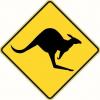As the new generation of bevel-up bench planes teaches us, it's the effective cutting angle, not the bedding angle, that matters when the blade is oriented bevel side up.
A bevel-down plane, on the other hand, is strictly limited by the bedding angle of the frog. The blade on a 45 deg smoother will always present at 45 deg relative to the wood, regardless of how it is beveled.
That being said, why is the common wisdom that a traditional plane iron should generally be beveled at 25-30 degrees? Why not 35-40 degrees? Wouldn't that make the cutting edge a bit more durable? So long as you bevel it a bit less than the 45 degree bedding angle to ensure relief, why would you want the bevel any sharper?
I used to think that a sharper bevel would make the blade cut better, but with these new bevel up smoothers and the steeply-pitched bevels, I'm beginning to wonder. I mean their function establishes the principle that it's the angle at which the leading edge meets the wood that matters, right?
Another way to look at it is: what does the wood care what is going on behind the leading edge of the blade? Besides reduced edge durability, what is a 30 deg bevel giving you that you can't get with a 35 deg bevel on a bevel down bench plane?
I'm sure I'm missing something here, just as I'm sure I'm thinking about this way too hard. Can anyone help me out?




 Reply With Quote
Reply With Quote




